A Conversation with Todd Deutsch

I’ve always found Todd Deutsch’s work quite intriguing, especially his series Family Days. For a large variety of reasons I personally would never be able to produce a body of work like that; and I finally asked Todd whether he’d be willing to talk about his work and some of the background. I’m very glad he agreed to participate.
Jörg Colberg: You describe “Family Days” as “an autobiographical project based on family, fatherhood, and young sons. The photographs describe the fatigue and tension that develop when the arrival of my third son upsets an already fragile domestic peace.” By construction, this is as personal a photographic project as one can get. When you started out to do this work, did you set yourself boundaries, did you decide about things that would be off-limits? And when the project developed and you got the photos, how far did the results actually stray from what you had originally planned?
Todd Deutsch: Not exactly. There were boundaries, sure, but they were pretty fuzzy. For the most part they were determined by my photographic interests and not by issues of privacy or personal space. Heidi and I met while undergrads in the photography program at the Minneapolis College of Art and Design, and she has a very keen sense of what makes photographs work. More importantly, she isn’t shy about telling me when I have missed
the mark. Every now and then I would run an image past Heidi just to be sure I wasn’t crossing an imaginary line. What I found was that it always came back to the central questions of sincerity and authenticity. Did the photograph accurately reflect life in our family? Was it in character? The pictures that cause me the most grief, mild as it is, are the pictures that in one way or another address insecurities about my skills as a father. It sounds really stupid but the images that give me pause are the pictures that have small parenting ‘transgressions’ in them. There is a magic list of things good parents allow and things bad parents allow. The good list includes vegetables and wooden toys, the bad list is made up mostly of McDonald’s and plastic swords. While I am sympathetic to the wooden toy list, I think of myself as more of a plastic-sword realist. Whenever a picture has a McDonald’s bag in it I feel a little twinge of apprehension. Of course those are the pictures that are the most interesting because they tend to be a little bit loose. Not quite as tidy and utopian as some of the others.
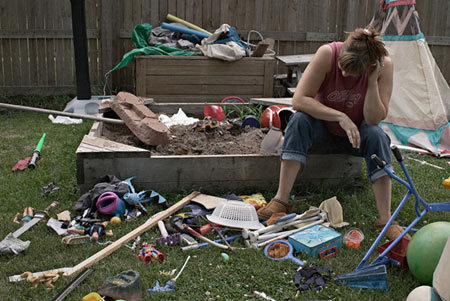
My intention from the beginning was to make pictures that were as honest a reflection of my family as I could muster. I had been photographing them for 7 or 8 years as a matter of necessity, curiosity, challenge, and sometimes desperation. “Family Days” started as a much larger project. On the day our third son was born I gave myself an assignment to make at least one photograph every day for that first year. The only rule was that it had to come out of daily routine. I knew that our lives were about to be turned upside down and it was likely that making pictures would be one of the first things to go. Finding a way to carve out a space for photography was essential. Daily routine was a way to make sure that I was always considering what was happening in the present. I had a vague idea that I might be able to turn it into something in the end, but my expectations were pretty low. The daily picture approach is really a very ham fisted way to develop a project. It was great for forcing me to shoot, but otherwise it was awful. My expectations changed about 6 months or so after the year ended and I started to look for some shape in the project. ‘A year in the life’ was just plain silly. I had to look for a more interesting thread that could be teased out of the collection. I am still not entirely convinced that I found the right thread, but I know that it is a step in the right direction.
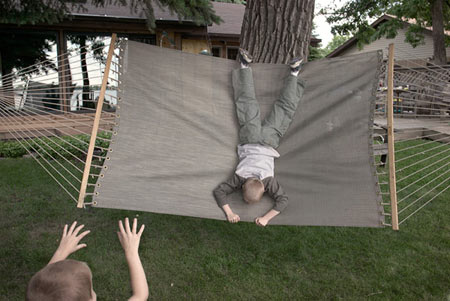
JC: Is this something that you’ve come across more often, that you find that whatever ideas you had about a photography project, when actually working on the project it turned out to be a bit different, so that, in the end, you had to adapt a little to what you got - instead of making the photos adapt?
TD: I don’t see how some give and take can be avoided, really. At least not in the way I like to work. Not letting the photographs take some responsibility for leading the way would be bad and not very interesting. Maybe if I had better ideas from the beginning it would be an advantage to bend the pictures to a concept, but I’m just not clever enough to do it. So far, the projects that I have had any lasting involvement with have come from very vague initial questions. The fact that the questions are mainly rhetorical and have no real answers is part of it, too. That initial ambiguity starts the train but does not provide an efficient way to get off. As a result, most of the cleaning up happens on the back end. It is only after looking at what I have been shooting that any sense of direction starts to emerge. Even then, what I think I see in the pictures changes dramatically from beginning to end. The difficult part is choosing one point on the horizon of many possible destinations. After I reach that point I might go out with some pictures in the back of my mind or be predisposed to ‘seeing’ certain things. Too much research and clarity in the beginning kills the magic. Of course, the magic is often annoying or distracting and not at all helpful in clarifying what I had hoped to find, but it is interesting in itself and leads to new projects. That kind of wandering curiosity seems to be embedded in the medium in some way. It is part of the DNA of photography. For me, making pictures is a little bit like gathering research data. Editing is the part where the analysis and interpretation occurs. That is also the part that gives me an ulcer.
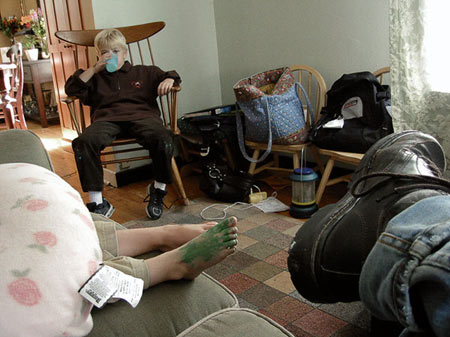
JC: Since I don’t have any children this might be a silly question, but let me ask this anyway. Documenting your “Family Days” transforms you from being “just” the father into someone who is more than that, namely someone who also wants to capture whatever is happening and who might have to be a bit detached from what is going on. Did you find your role as a father and partner changed and if so how did it affect the project and yourself?
TD: Yes, I am certain it has had an impact. Heidi had just gone back to school to become a nurse shortly before the project started. There was a lot of juggling going on. In the middle of our hectic schedules and tag-team parenting, the camera became a way to keep from being completely swallowed up by day-to-day responsibilities. It added to my list of worries, but it also slowed things down and kept me more attentive. In many ways I felt much more connected to what was happening around me during that time than I do now that I am not shooting as frequently. I was more conscious of details and the inevitability of change. That was both hopeful and frightening.
There is obviously a lot of social interaction involved in making photographs like these. When I am shooting I am participating directly in what is happening in the family. It is not always the deepest participation, but I am present in the moment. Of course, I am also working. The two things coexist. Not always comfortably, but they coexist. My studio is my dining room. When I am not shooting and I am doing something else like printing, answering emails, editing, whatever, the tension level in the house creeps up. My family starts to feel slighted and ignored. Even though I may be in the same room I am no longer participating, I am simply working. Both types of work involve detachment, but the character of each mode of detachment is very different. What it comes down to, I think, is the importance of carving out individual personal space within a family dynamic. Shooting is more directly connected to me personally, it supports my psychological and emotional well-being that in turn makes me a better father, partner, sibling, son, etc. Office work just makes me crabby. I guess what I am trying to say is that the distance that is sometimes necessary to make effective photographs is a healthy distance. It helps to provide some clarity in an otherwise emotionally chaotic life.
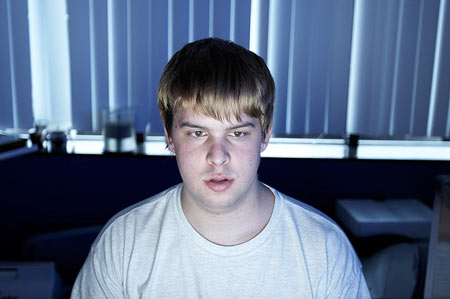
JC: I remember, back more than twenty years ago, I used to spend a lot of time hanging around the “home computer” departments of stores in my hometown, along with other kids interested in computers and, especially, games. It was a pretty weird group, with some of the kids socially quite awkward. Back then, I never thought much about what the group would look like for outsiders. With your project “Gamers”, you set out to document young males (today as back then, it was all males) getting together to play computer games. How did you get access to the group? Were people so detached from the world and so attached to their game worlds that they didn’t even care about what you were doing? Or did you bond with the kids in some way?
TD: The Gamers project was the result of following a tangent that developed during the editing of ‘Family Days’. When I was going through those pictures and thinking about emerging themes, my role in the family, what my sons were spending their time doing, and so on, I became interested in the world of boys and what they play with. Video games was one of several obsessions I saw brewing in my sons and their friends. I received a fellowship from the University of Minnesota/McKnight Foundation to make pictures that were about these obsessions. My plan was to go out and find the adult and adolescent versions of my own kids. What might they be like in the next 10, 15, or 20 years? So I started looking for gamers, action figure collectors, and Star Wars fans. My own experience with video games was stale and more than a few years out of date. When I started researching gaming culture I inevitably came across LAN parties. I had no idea they existed. It was radically different from what I had expected to find. I was apprehensive when I approached them because I assumed they would be very guarded. But access has not been an issue at all. In fact, the opposite is true. LAN parties are very social events in their own way. The games they play are typically first-person shooters and are extremely immersive. Much of the time is spent totally engaged in the game world, but it is a surprisingly social game world. Groups of players, called ‘clans’, interact in the game and communicate with each other using headsets. Every now and then when I am shooting I will hear someone say into the screen: “yeah, he’s working on a documentary”, or something like that. They are talking through the game with someone who is seated on the other side of the room. It is like neighborhood watch in there. It is very strange. The presence of another layer of connection becomes very clear. Much of the social interaction is immediately visible to anyone entering the building. It is no different than any other event. There is another social environment, though, that is only visible to those in the game. It is the tension between those two spaces, game space and real space, that I find very intriguing.
The vast majority of players at the events I have attended are young men in their late teens and early twenties. Many of them occupy the same social niche that I identified myself with at that age. I still do to the extent that I can get away with it without seeming pathetic. Something about it reminds me of skateboard culture in the 70s and 80s. As I envision it there is a great deal of similarity between these particular gamers and a group of skaters meeting at an empty swimming pool in the backyard of an abandoned house somewhere. Those are the guys I feel some affinity towards. The two cultures, in terms of a social attitude anyway, seem very much alike. It is very clear, however, that over time, as the LANs grow in size, a corporate presence becomes more and more evident. It will be interesting to watch what happens as the level of sponsorship increases.
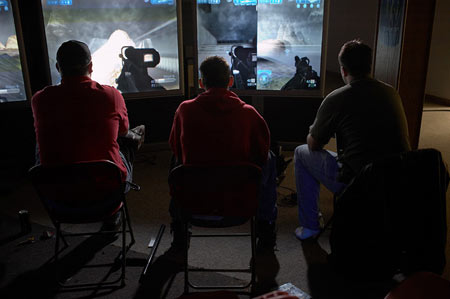
JC: I’ve talked about this with other photographers, and I’d be curious to learn what you think about this (especially given the fact that you also teach photography). Over the past few years, it seems that documentary and fine-art photography have started to overlap to an extent that sometimes, it’s not even obvious any longer what one is really dealing with. Work like your “Gamers” series is obviously more than “just” a series of fine-art photographs. I have this hope that these kinds of studies might mark the emergence of a socially very conscious style of photography, where the original motivation is somewhat detached from standard editorial work (where, more often than not, the photography is just the embellishment of someone else’s writing). What do you think about this?
TD: Dang, this is a big question. Making a photograph is in itself a socially aware gesture. It is the depth of that gesture that I get excited about. Amy Stein’s project Stranded comes to mind. I saw the photographs in Santa Fe and found myself visually enthralled. When she explained how they were made, that they were of people stranded on the side of the road, my appreciation of the work grew exponentially. I fell in love with the gesture. Imagining Amy crisscrossing highways and byways or hitching a ride with AAA in search of the stranded is as important to me as the resulting photographs. Is it an issue of effort or investment? Partly. But it is also more complicated than that. There are certainly projects that are logistically insane to pull off that just leave me cold, socially conscious or not. Yuri Kozyrev’s images in Time might serve as an example, albeit an imperfect example. His photographs from Iraq are meaningful in the extreme, and often fantastic. But I often find myself responding to them from a distance. I am moved, I am concerned, but I don’t often think about Kozyrev, and that is the point. It is journalism after all, the objective voice and all of that. In contrast to his usual journalistic images, a recent issue of Time contained a spread of his portraits of soldiers and the things they carry as good-luck charms. The idea implicates Kozyrev in a way that his other stories do not. The images, visually at least, compared to his other work, are not remarkable. The gesture is. I can’t stop thinking about them. In both cases I am conscious of the role of the photographer in a more than superficial way. What I think I see in Stranded and in The Things They Carry is something that has deeply affected the photographer. They are pictures made on a human rather than institutional scale. It is the difference between cultural anthropology and storytelling. My own interests fall more on the storytelling side of the spectrum. I want to know that the photographer was present, attentive, and motivated by a curiosity beyond the making of a picture. In an odd way, I also want that motivation to contain a hint of selfishness.

JC: So maybe it is then the role that a photographer decides to play that “determines” whether we are dealing with photojournalism or fine-art photography? I realize this is quite a silly way to phrase this, but I find this quite interesting, especially since it points to one of the big confusions with contemporary photography, where some photojournalists take quite artsy photos and many photographers, who do “fine-art” photography, produce work that could easily be used in sociological or anthropological textbooks. And most people decide about what they think they look at by what the photos look like or what context they’re shown in. “If it’s in a gallery, it must be fine-art.” Or a probably more common question “Why are those boring grids of water towers in a gallery?” I mean for photographers this all is really not a problem, but for large parts of the public it is. I have no idea how to deal with this, but I think that often enough, this complex leads to quite serious problems, for example when the aftermath of Hurricane Katrina disappears from the news and appears in fine-art galleries. Is there a way to deal with this, something to do about this? Or should we just let things evolve without being too worried?
TD: I say we just let it ride. For me the question raises an issue that I bump into all of the time. What do we as a culture expect of fine-art photography? I am not thinking about photographers for the most part, I am thinking very generically about large segments of the public. We had a discussion in an intro to photo class the other day about Luc Delahaye’s Taliban Soldier. The work was presented in the context of journalism initially. Everyone seemed to understand the necessity of showing uncomfortable images, and although the image was difficult and questions of privacy and responsibility were (predictably) trotted out, it was generally understood that it was an appropriate response to the situation. As soon as it became known that the picture was shown and sold in galleries the room got a bit prickly. After some discussion it seemed clear that the uneasiness came from a deeply seated assumption that the primary function of ‘fine art’ photography is, on some level at least, to entertain. It might be sophisticated, smart, and socially responsible, but at the end of the day it is really a form of entertainment and is subject to a different set of expectations. It is an oversimplification of what was going on, but a spectrum emerged: fine-art= classy entertainment, photo-journalism= necessary social information. For photographers this division of roles and expectations is crazy. For the general culture I think the division is largely held to be true. Art is a spectacle. That division is nothing new. The fact is, the ‘fine-art’ photography that gets airplay outside of enthusiast circles tends to be of two stripes: shocking and perceived as largely irrelevant to them, or mind numbingly beautiful. Extreme content or no content at all. Obviously, this is a huge mischaracterization of what is really going on in the world of fine art photography. As long as photographers continue making beautiful, thought provoking, sincere, socially aware work and actively seek the largest audiences they can find, the word will get out. I have to admit, though, that I have not spent a whole lot of time worrying about it. I guess I want to believe that people are generally capable of empathy regardless of context. Looked at another way, maybe the gallery keeps an event in the public eye in ways that journalism can’t. All photographs, given enough time, end up in a quasi-fine art/ historical context anyway. Eugene Smith’s Tomoko comes to mind. Or Brady’s Civil War pictures. Both are as much about the history of photography (more specifically, the position of their makers in the history of photography) as they are about industrial pollution or war. I would hope the two meanings could coexist without losing the capacity for empathy. Now, a loss of urgency? That is different matter altogetherÂ…
 By
By